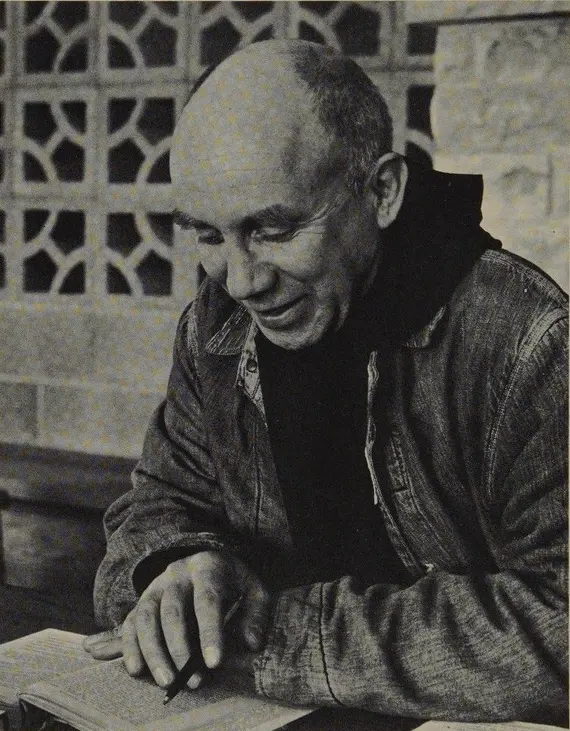vii Preface xi Editors’ Notes xii Foreword 1 Part One 1 3 The Eastward Flight / October 15-18 23 Calcutta / October 19-27 53 New Delhi / October 28-31 77 The Himalayas / November 1-25 191 Madras / November 26-28 211 Ceylon / November 29-December 6 247 Bangkok / December 7-8 257 Postscript 261 Part Two / Complementary Reading 293 Appendixes 295 I. September 1968 Circular Letter to Friends 297 II. On Mindfulness, by Bhikkhu Khantipalo 305 III. Thomas Merton’s View of Monasticism 309 IV. Monastic Experience and East-West Dialogue 318 V. Special Closing Prayer 320 VI. November Circular Letter to Friends 326 VII. Marxism and Monastic Perspectives 344 VIII. Letter to Abbot Flavian Burns 348 IX. The Significance of the Bhagavad-Gita 357 Bibliography 363 Glossary 419 Picture Credits 421 Index
p.190 (footnotes)
[113] Mouni Sadhu, who died in 1972, lived for many years in Australia, but he came from a German family, long resident in Poland, and his native language was German. He took the name “Mouni Sadhu” when he became a disciple of Sri Ramana Maharshi, the contemporary South Indian sage and teacher of Advaita Vedanta, and joined Maharshi’s ashram at Tiruvannamali. As a young man in Europe, he had belonged to an order of Rosicrucian Hermetists and published work on the tarot and on theurgy. Two of Mouni Sadhu’s books, Meditation and In Days of Great Peace, were in Merton’s personal library of Orientalia at Gethsemani. In Days of Great Peace (London, Allen 8c Unwin, 1957) carries the subtitle “The Highest Yoga as Lived” and is a diary (with flashbacks) concerned chiefly with the teachings of Maharshi, especially the technique of Jnana-Yoga (vichara) through which the transcendental spiritual state of samadhi may be achieved. In Australia, Mouni Sadhu established a group of Ramana Maharshi devotees, but the survival of some of his early interest in occultism led to its separation from the main body of the Maharshi cult. (In Sanskrit, “mouni” means “silent”; “sadhu,” “ascetic or holy man.”)
[114] Arthur Osborne: an English student of Hinduism and Vedanta, who died in 1971. He was a disciple of Sri Ramana Maharshi and spent the last twenty years of his life at Maharshi’s ashram in South India, where he edited the ashram journal, 'The Mountain Path'. His books include: Buddhism and Christianity in the Light of Hinduism, Ramana Maharshi and the Path of Self-Knowledge, The Collected Works of Ramana Maharshii, Teachings of Bhagavan Sri Ramana Maharshi in His Own Words, and The Incredible Sai Baba.
p.198
The trip to Mahabalipuram was fine. Especially the South Indian landscape under monsoon clouds. Dark green foliage, bright green paddy, thousands of tall palms, sheets of bright water, blue mountains in the south with fine shapes. I asked the Catholic driver if those were the mountains where Ramana Maharshi had been. He said yes and smiled. Then the sea, and the little thatched huts of the fishing villages. In a way all this was more charming than anything I had seen in India — more peaceful, more relaxed, better kept. Here one finally got some sense of what rural India might once have been.
p.207
is Bhagavan Sri Ramana Maharshi: (1879-1950) one of the great Hindu saints and teachers of modern times in India, accorded by popular devotion the title of “Bhagavan,” one of the supreme sages who are recognized as being “one with God.” Following a mystical experience of transformation at the age of seventeen, he set up an ashram at the sacred hill of Arunachala, where to the end of his life and attracting thousands of disciples, he taught a form of Advaita Vedanta (nonduality) through the discipline of self-examination. See Mouni Sadhu: In Days of Great Peace, London, Allen & Unwin, 1953; Arthur Osborne: Ramana Maharshi and the Path of Self-Knowledge, London, Rider, 1914, and New York, Samuel Weiser (paperback), 1970; Arthur Osborne, editor, The Collected Works of Ramana Maharshi, London, Rider, 19 — ; Arthur Osborne: Teachings of Bhagavan Sri Ramana Maharshi in His Own Words, London, Rider, 1962. Merton had studied the work of Maharshi at Gethsemani. (Dr. Raghavan has confirmed that the driver who thought the saint had lived in the mountains near Madras was mistaken. Arunachala is near Tiruvannamali, which is in Madras State, but a good hundred miles southwest of the city of Madras and about fifty miles inland from the sea.) In a private letter, Marco Pallis makes the interesting point that Ramana Maharshi “did not at any time become the disciple of a known guru; he is one who ‘perfected his sadhana [spiritual training] in a previous life.’ ” Merton’s notes on his reading of Maharshi are in Notebook 68 in the collection of his papers at the Thomas Merton Studies Center, Bellarmine-Ursuline College in Louisville, Kentucky.

